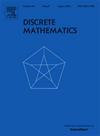Identifying codes in graphs of given maximum degree: Characterizing trees
IF 0.7
3区 数学
Q2 MATHEMATICS
引用次数: 0
Abstract
An identifying code of a closed-twin-free graph G is a dominating set S of vertices of G such that any two vertices in G have a distinct intersection between their closed neighborhoods and S. It was conjectured that there exists an absolute constant c such that for every connected graph G of order n and maximum degree Δ, the graph G admits an identifying code of size at most . We provide significant support for this conjecture by exactly characterizing every tree requiring a positive constant c together with the exact value of the constant. Hence, proving the conjecture for trees. For (the graph is a path or a cycle), it is long known that suffices. For trees, for each , we show that suffices and that c is required to have a positive value only for a finite number of trees. In particular, for , there are 12 trees with a positive constant c and, for each , the only tree with positive constant c is the Δ-star. Our proof is based on induction and utilizes recent results from Foucaud and Lehtilä (2022) [17]. We remark that there are infinitely many trees for which the bound is tight when ; for every , we construct an infinite family of trees of order n with identification number very close to the bound, namely . Furthermore, we also give a new tight upper bound for identification number on trees by showing that the sum of the domination and identification numbers of any tree T is at most its number of vertices.
在给定最大度的图中识别代码:表征树
无闭双图G的识别码是G的顶点组成的支配集S,使得G中的任意两个顶点在它们的封闭邻域与S之间有一个明显的交。我们推测存在一个绝对常数c,使得对于每一个n阶最大次为Δ的连通图G,图G承认一个最大(Δ−1Δ)n+c的识别码。我们通过精确地描述每棵需要正常数c的树以及该常数的精确值,为这一猜想提供了重要的支持。因此,证明树的猜想。对于Δ=2(图是一条路径或一个循环),人们早就知道c=3/2就足够了。对于树,对于每棵Δ≥3,我们证明c=1/Δ≤1/3是足够的,并且c只对有限数量的树要求为正值。特别地,对于Δ=3,有12棵树具有正常数c,并且对于每个Δ≥4,唯一的树具有正常数c是Δ-star。我们的证明基于归纳法,并利用了福科和Lehtilä(2022)[17]的最新结果。我们注意到,当Δ=3时,存在无穷多的树,其界是紧的;对于每一个Δ≥4,我们构造一个识别号非常接近边界的n阶无限树族,即(Δ−1+1Δ−2Δ+2Δ−2)n>(Δ−1Δ)n−nΔ2。此外,我们还通过证明任意树T的支配数与识别数之和不超过其顶点数,给出了树识别数的一个新的紧上界。
本文章由计算机程序翻译,如有差异,请以英文原文为准。
求助全文
约1分钟内获得全文
求助全文
来源期刊

Discrete Mathematics
数学-数学
CiteScore
1.50
自引率
12.50%
发文量
424
审稿时长
6 months
期刊介绍:
Discrete Mathematics provides a common forum for significant research in many areas of discrete mathematics and combinatorics. Among the fields covered by Discrete Mathematics are graph and hypergraph theory, enumeration, coding theory, block designs, the combinatorics of partially ordered sets, extremal set theory, matroid theory, algebraic combinatorics, discrete geometry, matrices, and discrete probability theory.
Items in the journal include research articles (Contributions or Notes, depending on length) and survey/expository articles (Perspectives). Efforts are made to process the submission of Notes (short articles) quickly. The Perspectives section features expository articles accessible to a broad audience that cast new light or present unifying points of view on well-known or insufficiently-known topics.
 求助内容:
求助内容: 应助结果提醒方式:
应助结果提醒方式:


